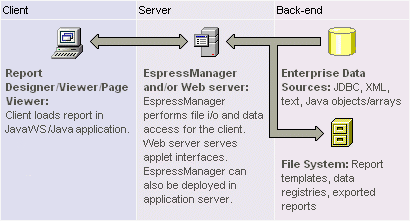Welcome to EspressReport. EspressReport is a powerful Java reporting tool that makes it easy to design and deploy information-rich reports with your internet or intranet applications. EspressReport can connect to virtually any data source and easily format and render the information in DHTML style sheets, print-quality PDF, Microsoft Excel, or Rich text. It can also extract data to text, CSV, and XML formats. The powerful Java API makes it easy to include reporting functionality in applications, servlets, JSPs, and JavaWS.
This is the EspressReport Quick Start Guide. This is the recommended starting point if you are new to EspressReport and would like to get up to speed fairly quickly, or evaluate the capabilities of the product. This portion of the documentation provides examples for designing and running reports, as well as sample reports and code that illustrate some of the most commonly used features of EspressReport.
EspressReport has a number of different configurations in which it can run both at design-time and run-time. At design-time, the Report Designer GUI interface, which includes data access tools and charting tools, can be loaded as an application on a client machine or as an applet in a client server architecture.
When Report Designer is running, the EspressManager component runs on the server-side. The EspressManager performs the data access and the file I/O which is prevented by the client applet due to security restrictions. The EspressManager also provides connection and data buffering for database connections, as well as concurrency control for a multi-user development environment. The EspressManager must be run in conjunction with the Report Designer.

EspressReport Architecture at Design-Time
At run-time, the EspressManager does not need to be running. EspressReport is designed to run embedded within other application environments and it can have a minimal deployment of the API classes and report template files. When running in an application server, the Report API can be used to generate reports within servlets and JSPs and stream the generated report to the client browser. Clients can also view reports by loading the Report Viewer applet.
Report generation can be handled on demand, triggered by application processes, or scheduled. A scheduler interface is also provided with EspressReport. In order to run the scheduler, the EspressManager must also be running.
For more information about EspressReport architecture and deployment options/configurations, please see Section 1.2 - Architecture & Installation, and Section 2.5 - Servlets and Java Server Pages of the Programming Guide.